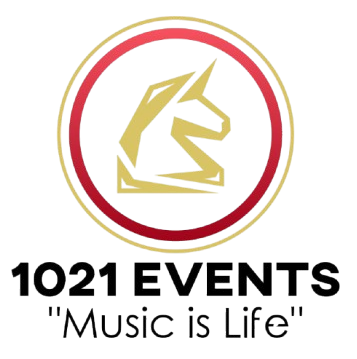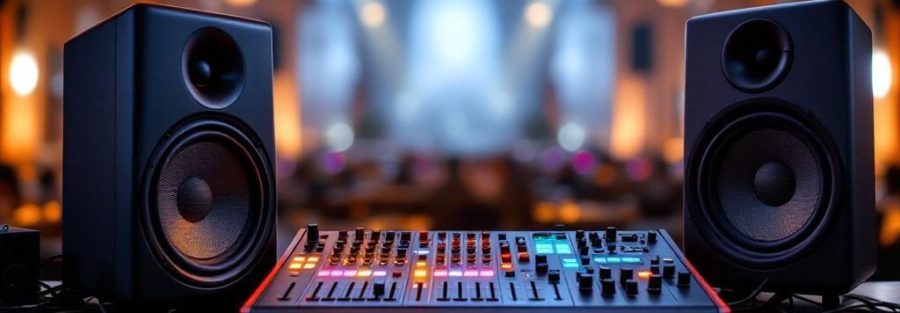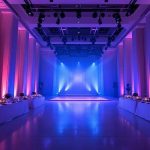Let's get straight to the point. When it comes to sound system rental prices, you're looking at a huge range—anywhere from $150 a day for a small, grab-and-go setup to well over $2,000 for a massive, concert-grade system that comes with its own crew. The final price tag really boils down to three things: the size of your event, the quality of the gear, and how much hands-on help you need.
What Do Sound System Rentals Actually Cost?
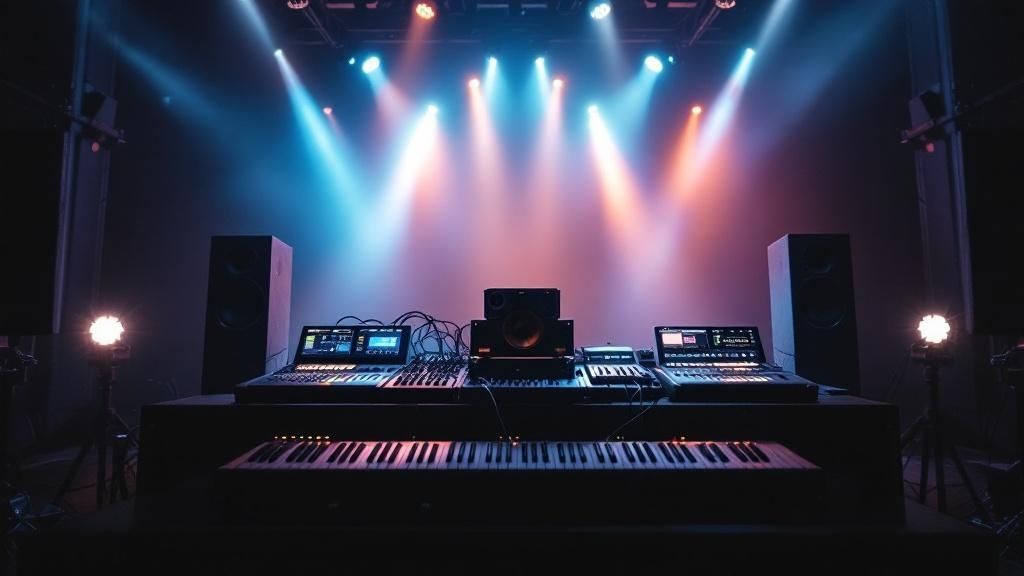
Think of renting a sound system like renting a car. You wouldn't rent a giant moving truck just to run to the grocery store, right? And you definitely wouldn't try to move your entire house in a tiny smart car. The same exact logic applies to audio for events.
Your equipment needs to scale with your event. For a small backyard party or a company meeting, a simple, portable PA system is your "compact car." It’s easy to use, light on the wallet, and perfect for smaller crowds. But for a big festival or concert? That’s when you need the "semi-truck"—a full line array system with thunderous subwoofers, a sophisticated mixing board, and a team of audio engineers who know how to run it all.
Setting a Realistic Budget
Figuring out which "vehicle" you need is the first step in setting a budget that makes sense. Before you get bogged down in tech specs and brand names, you just need to know if you're shopping for a basic package or a full-blown production. This one decision will guide everything else.
Getting this right helps you avoid two major pitfalls: either blowing your budget on gear you don't actually need or, arguably worse, cheaping out and leaving your guests straining to hear anything.
A wedding, for example, has its own unique audio needs. You need crystal-clear sound for the vows and toasts but don't want to blast Grandma out of her seat. We actually dive deeper into this in our guide to a wedding sound system rental.
The whole game is about matching the audio power to your event’s size and vibe. Nail this, and every announcement will be crisp, every song will have an impact, and you won’t have wasted a dime.
To give you a head start, we’ve put together a table breaking down typical rental costs by event size. Think of it as a cheat sheet to help you get a ballpark idea of what you can expect to pay.
Estimated Sound System Rental Prices By Event Size
A quick look at common rental packages, the events they suit, and their average daily rental costs to help with initial budget planning.
| Package Tier | Ideal For (Event Type & Size) | Typical Equipment Included | Estimated Daily Price Range |
|---|---|---|---|
| Basic DIY | Small parties, meetings, backyard BBQs (Up to 50 guests) | 2 small speakers with stands, a simple mixer, 1 wired microphone | $150 – $300 |
| Standard | Weddings, corporate seminars, small bands (50-150 guests) | 2-4 professional speakers, subwoofers, a digital mixer, 2 wireless mics | $300 – $750 |
| Premium | Large corporate events, fundraisers, outdoor festivals (150-500 guests) | Small line array system, multiple monitors, advanced digital console, mic package | $750 – $2,500+ |
| Concert | Major concerts, large-scale public events (500+ guests) | Full line array, extensive monitor setup, pro mixing desk, full crew | Varies Greatly (Custom Quote) |
This should give you a solid foundation for your budget. As you can see, the jump from a simple DIY setup to a professional rig is significant, but it all comes down to creating the right experience for your specific audience.
What Actually Goes Into Your Rental Price?
Think of renting a sound system like ordering a custom pizza. The base price gets you the dough and sauce, but every single topping—from the quality of the cheese to how many you pile on—changes the final bill. Getting a handle on what drives sound system rental prices is the first step to building a realistic budget.
The quote you get isn't just one number plucked from thin air. It's a combination of a few key things. Some are obvious, like how long you need the gear. Others are less so but just as important, like the acoustic quirks of your venue. Let's break down exactly where your money goes.
This image gives you a great visual of how equipment, event duration, and delivery costs all feed into the final price tag.
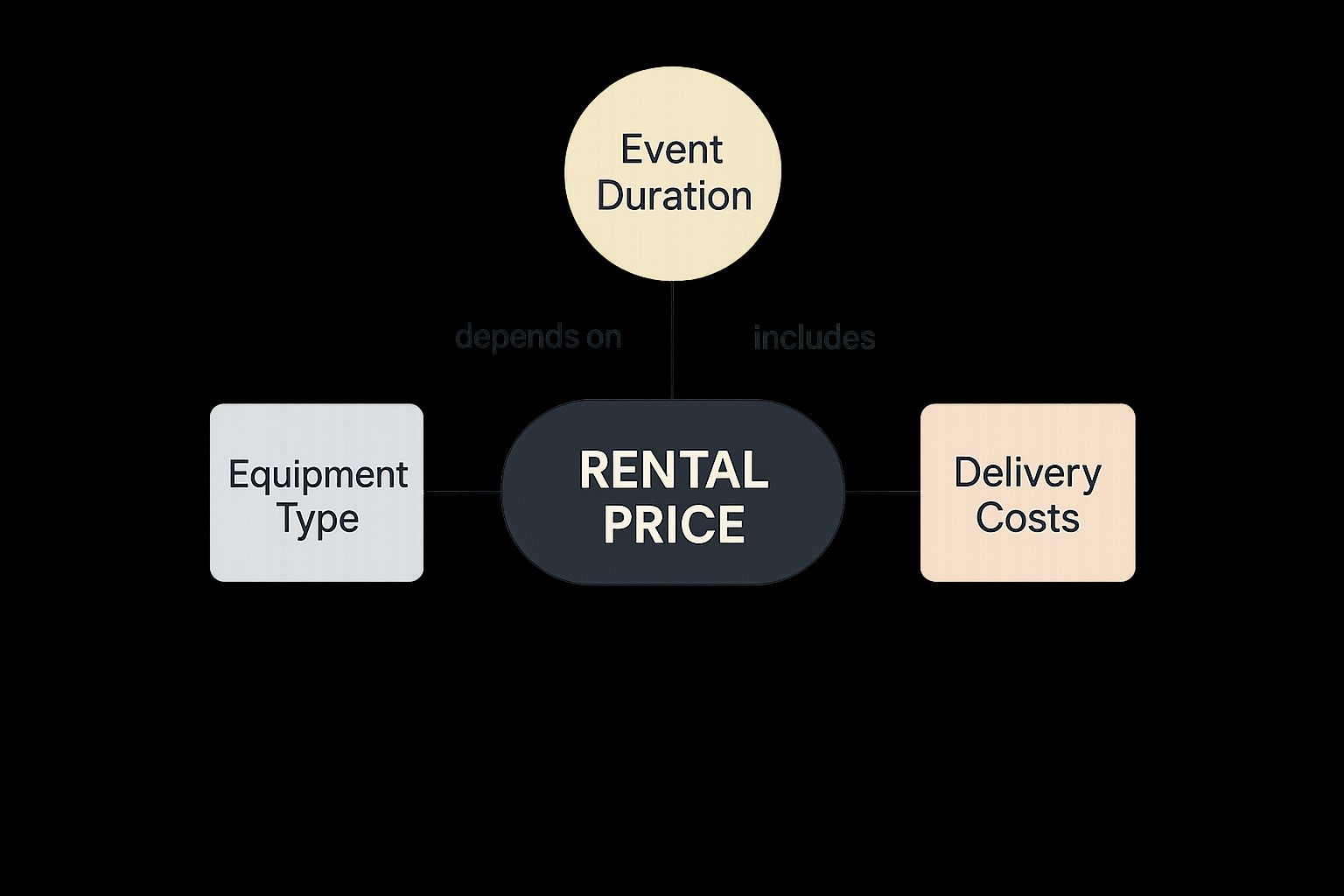
As you can see, these pieces are all connected. A change in one almost always affects the others, so it's good to know how they work together.
Equipment Quality and System Size
The biggest chunk of your cost will almost always be the gear itself. It's just like with cars—you have your reliable daily drivers and your high-end luxury models. Renting a top-of-the-line system from a premium brand like L-Acoustics or d&b audiotechnik will naturally cost more than a setup with popular workhorse brands like QSC or JBL, even if they seem to have similar power specs on paper.
The sheer size of the system is just as crucial. We're not just talking about volume; we're talking about coverage. A simple setup for a 50-person meeting is a world away from the gear needed for a 500-person outdoor festival. The more ears you need to reach, the more speakers, subs, and amps you’ll need, and that directly bumps up the rental price.
This is a huge industry, which just shows how much people value good sound. The global market for sound equipment rentals was pegged at $4.19 billion in 2024 and is expected to hit $6.01 billion by 2030. That growth comes from everything from corporate events to massive music festivals.
Rental Duration and Timing
This one's pretty straightforward: how long you need the gear matters. A one-day rental is the standard starting point, but most companies will cut you a deal for multi-day or week-long rentals. If your event runs all weekend, you might find that a three-day rental package is cheaper per day than booking three separate one-day rentals back-to-back.
Pro Tip: Don't be shy about asking for multi-day discounts! It's common for companies to offer a 3-day rental for the price of 2, or a weekly rate that saves you a bundle compared to paying the daily rate seven times over.
When you book can also make a difference. Trying to rent during peak season—think summer weekends or the December holiday rush—can mean higher prices because demand is through the roof. If you have flexibility, planning your event in the off-season could save you some cash.
Labor and Technical Crew
Here's a big question that will definitely affect your budget: do you need a pro sound engineer to run the show? A "dry hire" means you’re just renting the gear and you (or someone on your team) are responsible for setting it up and running it. A "wet hire" means the rental comes with a trained technician or even a full crew.
Here’s a quick way to think about it:
- Dry Hire (Equipment Only): This is your best bet for simple gigs, like a small PA system for speeches at a meeting. If you're comfortable plugging in a few cables, this is your cheapest option.
- Wet Hire (With Crew): This is non-negotiable for more complex events like live bands, big conferences, or any situation where the audio absolutely has to be perfect. A sound engineer can run anywhere from $50 to over $100 per hour.
For a lot of private parties and weddings, the audio person wears multiple hats. Often, the sound tech is also the DJ, who keeps the music flowing and the energy up. If you're looking to hire entertainment too, check out our guide on how much a DJ costs for a party to see how you might bundle these services.
Venue Complexity and Logistics
Last but not least, where your event is happening plays a huge role. An indoor conference room with good acoustics and plenty of power outlets is a piece of cake. An outdoor wedding on a sprawling lawn? Or a concert inside a cavernous, echo-y gymnasium? Those present real acoustic challenges that often require more specialized gear and expertise to get right.
Getting the gear to and from your event also adds to the cost.
- Delivery & Pickup: Most companies will charge a fee for this, usually based on the driving distance and how much gear needs to be hauled.
- Setup & Teardown: Unless you’re doing it yourself, you'll be paying for the crew's time to get everything set up before the event and torn down after.
- Venue Weirdness: Things like a difficult load-in area (e.g., three flights of stairs and no elevator) can add labor fees.
Once you have a good grasp of these factors, you can have a much smarter conversation with rental companies and keep your event budget from getting out of control.
How to Decode Your Sound System Quote
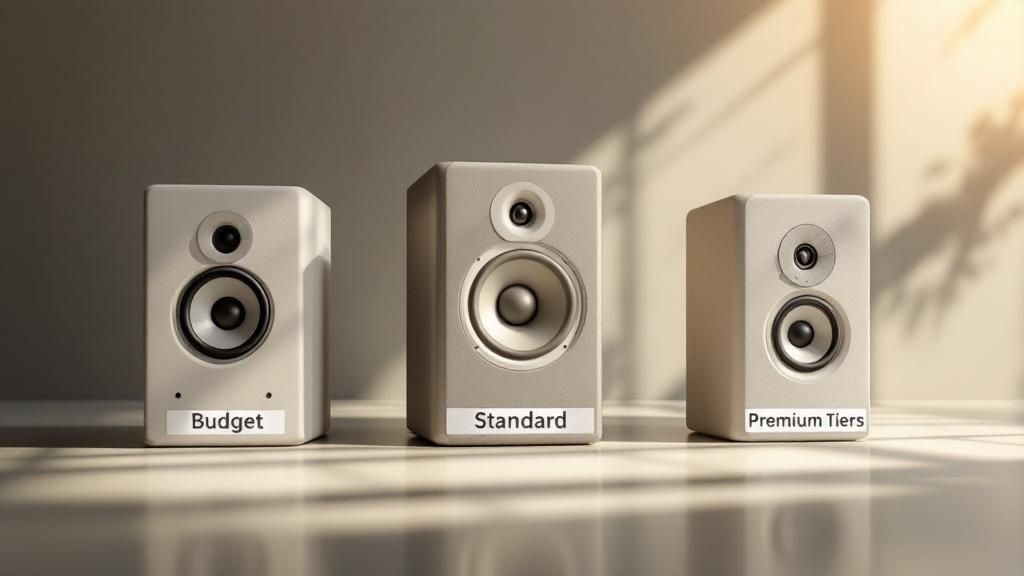
So, you’ve got a quote in hand, and it’s filled with industry jargon that might as well be in another language. Words like "FOH," "Monitors," and "Rigging" are tossed around, and you're left scratching your head, wondering what on earth you're actually paying for. I get it. This part is your personal translator, designed to break it all down so you know exactly where your money is going.
Think of your quote as the recipe for your event's sound. Each line item is an ingredient. Once you understand what each one does, you can see why it’s essential for the final product. Being able to read the recipe helps you make smarter choices about your sound system rental prices.
Breaking Down the Equipment List
First things first, let's tackle the gear. Your quote will have a list of technical terms that can look pretty intimidating. Don't sweat it. Each piece of equipment has a very specific job.
-
FOH (Front of House) Speakers: This is the main PA system—the speakers pointed directly at your audience. They're responsible for delivering the primary sound for everything from music to speeches. The size and power of these will depend entirely on how big your event is.
-
Stage Monitors (or Wedges): Ever see those speakers on stage pointed back at the performers? Those are monitors. They let musicians and speakers hear themselves clearly, which is absolutely critical for a good performance. A keynote speaker might not need them, but a live band can't function without them.
-
Subwoofers (or Subs): These are the big boys built for one thing: low-frequency sounds. They create that deep, chest-thumping bass you feel at a concert. If your event is music-focused, subs are a must-have.
-
Snake Cable: This is just a fancy name for a thick, multi-channel cable that keeps the stage tidy. Instead of running a dozen individual microphone cables from the stage to the sound booth (a tripping nightmare!), the snake bundles them all into one neat line.
Knowing these key components helps you understand the "why" behind the gear list. It's not just a random assortment of equipment; it's a system designed specifically for what you're trying to do.
Differentiating Between Costs
Beyond the list of gear, your quote will have different types of charges. Getting a handle on what these are is the key to comparing quotes from different companies and making sure there are no hidden fees.
A detailed, transparent quote is the sign of a pro. If a company gives you a vague, single-price quote, don't be shy about asking for an itemized breakdown. You have every right to know exactly where your money is going.
Here are the main cost categories you'll almost always see:
-
Equipment Costs: This is the base rental fee for all the hardware—the speakers, mixers, mics, stands, and cables. This part of the bill is usually the biggest chunk of your total cost.
-
Labor Fees: This is what you pay for the pros. It covers the time and expertise of the sound engineers and technicians who deliver, set up, operate, and tear down the system. Labor is often billed by the hour, and you can expect higher rates for nights or weekends.
-
Delivery & Transportation: This fee is all about logistics—getting the gear from their warehouse to your venue and back again. It’s usually calculated based on the distance, the size of the truck needed, and the time it takes.
-
Damage Waiver or Insurance: Most rental houses will add a small percentage (usually 5-10%) to the equipment total for a damage waiver. This little fee gives you peace of mind by covering you for accidental damage. Without it, you could be on the hook for the full, and very expensive, replacement cost of the gear.
Matching the Right Sound System to Your Event
Let's get practical. You wouldn't bring a megaphone to a rock concert or set up a stadium PA system for an intimate wedding toast. Picking the right tool for the job is the single most important thing you can do to get great sound, and it's what really drives your final sound system rental prices.
This is where the rubber meets the road. We're connecting your event's specific needs to actual equipment packages. The goal is to find that perfect sweet spot: amazing audio that elevates the experience without completely wrecking your budget. You don't want to pay for gear you don't need, but you definitely don't want to cheap out and have your guests straining to hear what's going on.
It’s no surprise that more people are renting audio gear than ever. The global audio equipment rental market is expected to jump from USD 5.2 billion to USD 8.4 billion between 2023 and 2033. Why? Because live events are booming, and organizers know that quality sound is non-negotiable. Renting just makes sense—it’s cost-effective and gives you access to the best tech without the hefty price tag of ownership.
For Weddings Vows and Toasts
Weddings are a fantastic example of an event that needs a little bit of everything. You need crystal-clear audio for the vows during the ceremony, but you also need music with enough oomph to get everyone on the dance floor at the reception.
A typical wedding package is all about versatility:
- Lapel Microphones: These are a must-have for the officiant and the couple. They make sure every word of the vows is heard perfectly, all without a big, clunky microphone showing up in every single photo.
- Wireless Handheld Mics: Perfect for passing around for toasts, announcements, and speeches during the reception. They give speakers the freedom to move around and engage with the crowd.
- Compact Speakers and Subwoofers: A couple of high-quality speakers can easily fill the reception hall with music. Adding a small subwoofer provides that warm, low-end punch for the dance music without being so loud that people can't hold a conversation.
Getting this balance right is what makes the magic happen. The right system creates that emotional gut-punch during the ceremony and then brings the energy for the party later on.
When you're planning a wedding, sound is just one piece of a much bigger puzzle. The audio, lighting, and DJ all have to work in harmony to create the perfect vibe. For a deeper dive, check out our guide on how to plan a successful event.
For Corporate Conferences and Presentations
For corporate events, it’s all about two things: clarity and professionalism. The main goal is simple—every single person in that room, from the front row to the back corner, needs to hear every word from the presenter. If the audio is muffled or cuts out, the speaker can look unprepared and the audience will tune out fast.
Here’s what a standard corporate audio rental often includes:
- Podium Microphone: A classic gooseneck mic attached to the lectern is the standard for keynote speakers.
- Multiple Wireless Mics: You'll want handhelds for audience Q&A sessions and probably some lapel mics if you have a panel discussion.
- Evenly Distributed Speakers: Instead of just two huge speakers blasting from the front, a corporate setup often uses several smaller speakers placed strategically around the room. This ensures everyone gets the same clear, consistent volume.
Reliability is absolutely non-negotiable here. You just can't have a mic die in the middle of the CEO's big speech. That’s why professional-grade equipment and, often, an on-site audio tech are pretty much standard for these kinds of events.
For Live Bands and DJ Performances
When music is the main event, the whole game changes. You're not just making a voice louder anymore; you're mixing a complex, multi-layered performance. This is usually the most involved—and most expensive—type of sound rental.
A live band needs a system that can juggle a bunch of different instruments and vocals all at once.
- Stage Monitors: This is a huge one. Each musician needs their own speaker (a "monitor") pointed right at them so they can hear themselves and each other. Without good monitors, the whole performance can quickly fall apart.
- A Robust Mixing Console: That little mixer you used for the wedding won't cut it here. You need a big, multi-channel board that lets an engineer finely tune and balance the levels of the drums, bass, guitars, keyboards, and all the vocals.
- Powerful Subwoofers: To really feel the music—the kick of the drum and the rumble of the bass guitar—you need powerful subwoofers to deliver that low-end impact.
With a live performance, it's less about just making things loud and more about creating a clean, powerful, and perfectly balanced mix that sounds incredible for the audience.
Sample Sound Packages For Common Events
To give you a clearer picture, let's look at how these different needs translate into real-world packages. The table below breaks down some typical audio setups and estimated costs for different events. Think of it as a starting point to help you figure out what you might need.
| Event Type | Key Audio Needs | Example Equipment Package | Potential Add-Ons |
|---|---|---|---|
| Wedding | Speech clarity (vows, toasts) & music for dancing | 2 speakers, 1 subwoofer, 2 lapel mics, 1 handheld mic, small mixer | Projector & screen, uplighting, DJ equipment |
| Corporate Conference | High speech intelligibility, even coverage for a large room | 4-6 distributed speakers, podium mic, 4 wireless mics (handheld/lapel), medium mixer | Audio technician, presentation clicker, confidence monitors, livestreaming gear |
| Small Live Band | Individual monitoring for musicians, balanced mix for audience | 2 main speakers, 2 powerful subwoofers, 3-4 stage monitors, drum mics, 16-channel mixer | Stage lighting, backline amps, audio engineer |
| DJ Performance | Deep bass, high volume capacity without distortion | 2 powerful main speakers, 2-4 large subwoofers, DJ booth monitor, DJ controller/turntables | Haze machine, advanced lighting rig, larger sound system for bigger crowds |
Remember, these are just examples. The right package for your event will always depend on the specifics of your venue, audience size, and what you're trying to achieve. Always talk through your vision with the rental company to get a truly custom solution.
Smart Ways to Save Money on Your Sound Rental

Getting incredible sound for your event doesn't have to mean emptying your wallet. While sound system rental prices can seem steep at first, there are plenty of practical ways to get the cost down without making your event sound cheap. It all comes down to a little planning and smart thinking.
Think of it like booking a flight. The price you pay is all about when you book, what’s included, and how long you're going for. The same logic applies to renting audio gear. A little strategy can go a long way.
Book Early and Consider the Off-Season
Honestly, one of the easiest ways to save is just to plan ahead. Locking in your equipment well in advance—especially for a popular summer weekend or holiday—almost always gets you a better rate before demand spikes. Wait until the last minute, and you’re looking at rush fees and picking from what’s left over, which is usually the pricier stuff.
If your date is flexible, think about hosting your event during the off-season. Rental companies are slammed from May to October. An event in January or March? You'll likely find a much friendlier price tag simply because there's less competition for the gear.
Bundle Your Services for Bigger Discounts
A lot of event production companies do more than just sound. They often handle lighting, video, staging, and even photo booths. Instead of juggling three or four different companies, see if you can bundle services together.
Bundling is a classic win-win. The rental company gets more business from one client, and you get a single point of contact and, most importantly, a solid discount.
This doesn't just save you cash; it makes your life easier. Having one crew manage all the tech means less back-and-forth and a smoother event day. If you're already considering fun extras, you can check out the average cost of photo booth rental to see how that could fit into a bigger package deal.
Extend Your Rental for a Better Daily Rate
This might sound backward, but renting for longer can actually drop your per-day cost. Most companies have discounted rates for multi-day or weekly rentals. A three-day weekend rental might only cost 1.5 or 2 times the single-day price, which is a fantastic deal if your event spans a few days.
Always ask about their pricing for longer periods. If you're setting up on Friday, holding the event on Saturday, and tearing down on Sunday, a weekend package will beat paying three separate day rates every time. It's a standard industry practice and an easy way to make your budget work harder.
Choose Between Dry Hire and Wet Hire
A huge chunk of your cost can come down to whether or not you need a pro to run things.
A "dry hire" is just the gear. You pick it up, set it up, and run it yourself. This is your cheapest option, perfect for simple things like plugging in a playlist or making a quick announcement.
A "wet hire," on the other hand, includes a professional sound engineer. It costs more, but it buys you peace of mind. For anything complex—like a live band, a panel discussion with multiple mics, or a big conference—a technician is essential. But for a simple speech or a DJ set where you just need speakers, going with a dry hire can save you hundreds in labor costs.
Frequently Asked Questions About Sound Rentals
Alright, so you've got a plan, but a few questions are probably still bouncing around in your head as you get ready to book. That's totally normal. Getting these common questions answered will give you the confidence to lock in your audio gear without any second-guessing.
Let's clear up some of the most common things people ask about sound system rentals.
Do I Really Need a Sound Engineer?
This is a big one, and the answer really boils down to how complicated your setup is.
If you're just grabbing a small PA system for some background tunes and a single mic for a speech, you can probably handle it yourself. This is what we call a "dry hire." The rental company will give you a quick rundown, and it's usually just a matter of plugging a few things in. Easy peasy.
However, if your event involves a live band, multiple speakers using lapel mics, or any scenario where the audio absolutely has to be perfect, then yes, you need a sound engineer. It's not really optional at that point. Their whole job is to make sure everything sounds smooth and professional, and they are worth every penny when the stakes are high.
Here's a good rule of thumb: The more microphones and inputs you have, the more you need a pro. An engineer does way more than just turn knobs. They're actively mixing sound, killing feedback before it starts, and solving problems you didn't even know were coming.
How Far in Advance Should I Book?
Timing is everything, especially during the busy season (think late spring through early fall).
For bigger events like a wedding or a corporate conference, you’ll want to book your sound system 3 to 6 months ahead of time. For smaller gatherings or parties, 1 to 2 months out is usually a safe bet. Booking early doesn't just guarantee you get the gear you want; it can sometimes lock in better pricing, too.
This also goes for hiring a DJ who brings their own equipment. If you're going that route, check out these crucial questions to ask your wedding DJ before you sign on the dotted line.
What Happens If Equipment Gets Damaged?
Accidents happen. Spilled drinks, a tripod gets knocked over… rental companies have seen it all.
This is why most will require a damage waiver with your rental. It’s typically a small fee—around 10% of the rental cost—that acts like insurance for accidental damage. It’s a lifesaver. Without it, you could be on the hook for the full replacement cost of some seriously expensive equipment. It's a small price to pay for peace of mind, so always ask about the damage waiver policy upfront.
